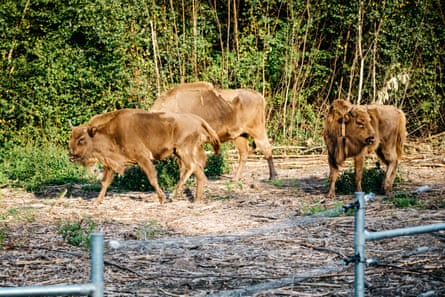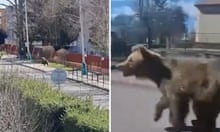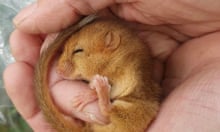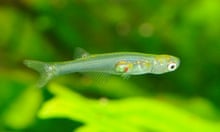A pioneering rewilding project has had an early surprise: a bouncing baby bison. It is the first wild bison to be born in the UK for thousands of years.
Three bison were released in Kent in July but, unknown to the rangers, one had a secret passenger on board. Bison conceal their pregnancies to prevent predators targeting pregnant animals or their offspring.
The female calf was discovered after a couple of days when rangers did not see the mother, who had found a secluded location to give birth. “The calf has come on leaps and bounds – literally,” said Tom Gibbs, a bison ranger. She loves to run circles around the adults, he added.
The project is a collaboration between the Kent Wildlife Trust and Wildwood Trust and they had hoped the new herd would breed in due course, but the new baby is a bonus. A bull is expected to arrive from Germany to join the three female bison by the end of October.
“There were a couple of days when we didn’t see female 2 and that was sort of an alarm bell, because she’s normally very confident and the one up at the front. I hoped she was OK,” said Gibbs. “The other two females were also a bit more on edge and defensive, warning me about something.”
“I went off to try and to find her and after about an hour, I could hear some rustling in the tree line,” Gibbs said. “I didn’t want to get too close, so I used my binoculars, and I could see her tail swishing. I thought I saw a muntjac deer behind her, and I thought: ‘What’s that doing, so close to this female?’
“Then, lo and behold, this little face popped out from behind the female, and that was the eureka moment. It was just unbelievable to think this is the first wild born bison here in England. It was just a monumental moment.”
Gibbs and fellow ranger Donovan Wright had an inkling something was afoot in the days before the birth. “She had definitely been increasing the amount that she was eating,” said Gibbs. “She’s normally pretty picky, but it turns out she was eating for two.” Her udder was also slightly swollen, but the rangers thought she may simply have been coming into her fertile period, as calves are most commonly born by July.
The calf has developed fast, Gibbs said: “It’s amazing, within a week she was so sure on her feet. She now seems to absolutely love the rain and she’ll hare around in circles, doing donuts.” She was also eating solids, by nibbling at leaves.
The new arrival has been welcomed by the other adult bison, who clean her and screen her off if they perceive a threat. They also keep an eye on the calf when the mother is resting, akin to babysitting, said Gibbs.
The calf was probably born on 9 September, but the announcement was delayed owing to the death of Queen Elizabeth II the previous day. “We also wanted to make sure that the calf was healthy,” Gibbs said.

The project has issued an appeal for donations to continue its work assessing how bison act as “ecosystem engineers” to restore wild habitat. “This is going to be a blueprint that will hopefully act as guidance for other interested organisations and landowners,” said Gibbs.
The matriarch came from a wildlife park in Scotland, while the new mother and another young female came from a park in Ireland, where the calf will have been conceived. The bull’s arrival has been delayed by Brexit-related complications.
The bull will be introduced gradually, but the rangers do not expect problems. “The matriarch rules the roost – she’s top of the hierarchy at all times and he’ll conform to what she dictates. His interest will be in the older females, not the calf.”
The project site is licensed for up to 10 bison and in future, it hopes to provide bison to found other sites in the UK, as well as exchanging animals across Europe. All 9,000 bison now living in Europe are descended from just 12 zoo animals, which saved the species from extinction in the early 20th century, so maximising genetic diversity is important.
after newsletter promotion
Bison’s taste for bark kills some trees and their bulk opens up trails, letting light spill on to the forest floor, while their love of rolling around in dust baths creates more open ground for new plants, invertebrates and birds. The Wilder Blean project aims to naturally regenerate a former pine wood plantation.
The process has been surprisingly speedy, said Gibbs, who has seen slow worms basking and heard more birdsong. “We had not seen dung beetles on the site but all of a sudden, they are just thriving,” he added.
Vicki Breakell, conservation officer at the Wildwood Trust, said: “They’ve created tracks and pathways, which has opened up the canopy already, and they’ve been munching on the bark, which over time is going to create the standing dead wood which is so valuable for a whole host of different species.”

The bison are currently in a five-hectare (12-acre) enclosure, as they adapt to their new lives and their health is closely monitored. They will be moved to an area of 50-hectare next and then, next summer, the full 200-hectare site.
The bison will live entirely wild lives, but came from parks where they were given supplemental feed, which they are now being weaned off. “It’s very small amounts and they are getting the majority of their food from natural foraging,” said Gibb.
The project is gathering lots of scientific information to assess the rewilding impact of the bison, which will be helped by Exmoor ponies and Iron Age pigs from early 2023. A second large area will have wild-living long-horn cattle instead of bison, and a third area without the animals will be a control area for the conservation experiment.
Populations of the UK’s most important wildlife have plummeted by an average of 60% since 1970 and Britain is one of the most nature-depleted countries in the world.









